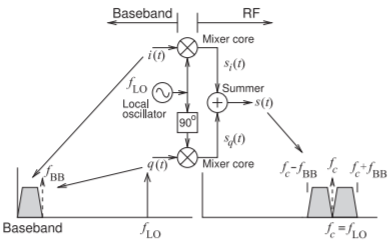3.15: Introduction to Software Defined Radios
- Page ID
- 41201
The 2G and 3G cellular radio schemes used very few modulation methods. With the introduction of 4G and now 5G many modulation methods must be supported with the highest-order modulation scheme used determined by the level of noise and interference on a channel. This support for multiple modulation methods is only possible if most of the demodulation process is performed in DSP where software controls demodulation. Such a radio is called a software defined radio (SDR). In an SDR many of the functions that traditionally would be performed using analog hardware are instead implemented digitally and only the RF functions close to the transmit/receive antenna are implemented in analog form. An extreme concept for the transmitter side of the radio is to implement all of the functions digitally with a final digital-to-analog converter (DAC) connected to an antenna. Then the performance is limited by the maximum frequency and output power of the DAC. This ultimate SDR provides maximum flexibility, for example, it is easy to change modulation schemes, but would also contribute to very high battery drain. So instead there is a trade-off with many aspects such as modulation and fine tuning of the RF carrier frequency done digitally while, with a transmitter, the final up-conversion done using analog hardware which only needs to be able to support the bandwidth of the modulated signal but otherwise is agnostic to the type of modulation used.
All radios today use quadrature modulation, a type of digital modulation, in which the real (in-phase) and imaginary (quadrature-phase) components of the phasor of the carrier are varied independently. While it is possible to vary the amplitude and phase of a carrier tone separately this is not common.
Quadrature demodulation recovers the original signals that varied the in-phase and quadrature-phase components of the carrier. Demodulation can proceed in stages with an initial analog separation of RF in-phase and quadrature signals which are sampled by an analog-to-digital converter (ADC) and demodulation completed in a digital signal processor.
The following sections discuss various aspects of an SDR radio. Section 3.9 begins with a description of quadrature modulation in a way that helps in the understanding of an SDR transmitter. In Section 3.10 a specific example of an SDR transmitter is presented in which the time-domain and frequencydomain signals are followed through first a digital signal processor (DSP) and then an analog up-converter to produce an RF signal. This discussion is followed by a description of an SDR receiver with the general SDR quadrature demodulator in Section 3.11 and then a specific example in Section 3.12.

Figure \(\PageIndex{1}\): Double-sideband suppressed-carrier (DSB-SC) modulation. Quadrature modulator with independent modulating baseband signals \(i(t)\), the in-phase component input to the in-phase mixer core, and \(q(t)\), the quadrature component driving the quadrature-phase mixer core. This results in a modulated signal with two sidebands around the local oscillator or carrier frequency. Each RF sideband has a mix of the information in \(i(t)\) and \(q(t)\).


